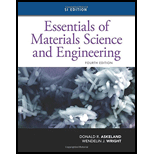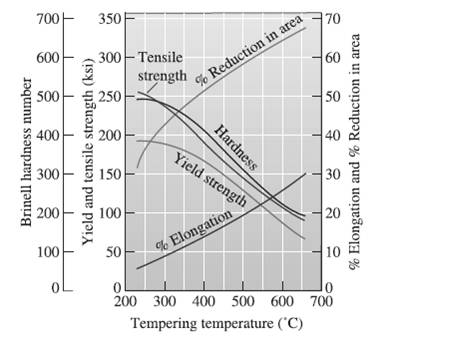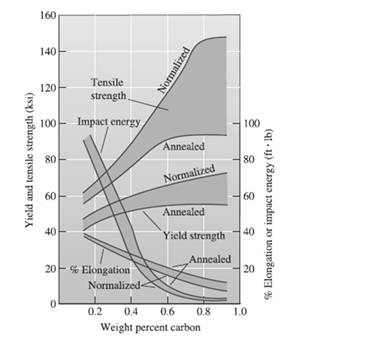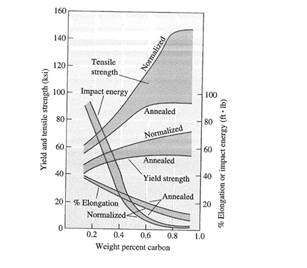
(a)
Interpretation:
By using

Concept Introduction:
Heat treatment is the metalworking process used to change the physical properties as well as chemical properties of the material that treatment is commonly used in metallurgical for the manufacturing of glass. Heat treatment uses heating on chilling to the extreme temperature to achieve desired properties such as hardening or softening of a material. Under heat treatment various technique uses such as annealing case precipitation, hardening, strengthening, tempering & carburizing quenching.
(b)
Interpretation:
The yield & tensile strength of

Concept Introduction:
Heat treatment is the metalworking process used to change the physical properties as well as chemical properties of the material that treatment is commonly used in metallurgical for the manufacturing of glass. Heat treatment uses heating on chilling to the extreme temperature to achieve desired properties such as hardening or softening of a material. Under heat treatment various technique uses such as annealing case precipitation, hardening, strengthening, tempering & carburizing quenching.
(c)
Interpretation:
The yield strength tensile strength & % elongation of the

Concept Introduction:
Heat treatment is the metalworking process used to change the physical properties as well as chemical properties of the material that treatment is commonly used in metallurgical for the manufacturing of glass. Heat treatment uses heating on chilling to the extreme temperature to achieve desired properties such as hardening or softening of a material. Under heat treatment various technique uses such as annealing case precipitation, hardening, strengthening, tempering & carburizing quenching.
Trending nowThis is a popular solution!

Chapter 13 Solutions
Essentials Of Materials Science And Engineering, Si Edition
- E. How many stages it has? Explain the function of each one. F. Construct the truth table and explain it briefly. G.How can you convert this circuit to an open collector form? Explain and sketch it. H.How can you convert this circuit to a tri-state form? Explain and sketch it. I. How can you prevent the transistors from being saturated? J. Which transistor should be modified to convert this circuit to a 4-inputs NAND? Explain and sketch it. K.Convert this circuit to a 2-inputs NOR gate and draw it. R-4.2K W R-1200 R-1.5K R-IK Figure (1) JOUT e Yourarrow_forwardA 4 inch wide, 12 inch tall cross section beam is subjected to an internal shear of 5.5 kips. What is the maximum transverse shear stress in the beam in psi if this bending is about the x axis?arrow_forwardA3Q3.c - You are to write a C program that implements the following disk scheduling algorithms: a. FCFS [10 marks] b. SCAN [10 marks] c. C-SCAN [10 marks] d. SSTF [10 marks] e. LOOK [10 marks] f. C-LOOK [10 marks] • Your program will service a disk with 300 cylinders numbered 0 to 299. • • • • The program will service the requests (a list of 20 cylinder numbers) given in the file request.bin. This file contains (4 byte) integer values representing requests ranging from 0-299. Your program will take the initial position of the disk head as the first command line argument and the direction of the head as the second command line argument. It will then output the requests in the order in which they are serviced, and the total amount of head movements required by each algorithm. In particular, your program needs to do the following: Your program should take two command line arguments a) First command line argument - initial position of the disk head (an integer value) b) Second command line…arrow_forward
- Question 3 (20 points): The traffic volume on a 2-lane highway is 1600 veh/hr in each direction Page 3 of 6 with a density of 20 veh/mi. A large dump truck enters the traffic stream from an adjacent construction site at 20 mph and carries on this way for 2 miles before turning off to the dump site. Because flow is so high in the opposite direction, no one can pass the truck. As a result, traffic back up behind the truck at four times the density (i.e., 4x20 = 80 veh/mi) at a volume of 1000 veh/hr. How many vehicles get caught in the traffic congestion before the truck exits the highway?arrow_forward1. Determine the z-transform, including the region of convergence (ROC), of the following signals: a)x[n={3,0,0,0,0,51-4} b) x2[n] = ((1/3)^n ,n ≥0 2", n < 0 c) X3[n]= (1/3)^n- 2", n ≥ 0 0, n < 0arrow_forwardA Brayton cycle produces 14 MW with an inlet state of 17°C, 100 kPa, and a compression ratio of 16:1. The heat added in the combustion is 960 kJ/kg. 0.7 MW of heat transferred from the turbine to the environment. What are the highest temperature and the mass flow rate of air? Assume cold air properties.arrow_forward
- Use ECL configuration to realize a 2-inputs OR /NOR gate and verify its function using the truth table, showing the state of each transistor in the circuit. Assume Vcc 5V, VEE-0V & VREF=1.5V.arrow_forward2. The memory management has contiguous memory allocation, dynamic partitions, and paging. Compare the internal fragmentation and external fragmentation for these three approaches. [2 marks] 3. Suppose we have Logical address space = 24 = 16 (m = 4), Page size=2² =4 (n = 2), Physical address space = 26 = 64 (r = 6). Answer the following questions: [4 marks] 1) Total # of pages ? 2) Total # of frames ? 3) Number of bits to represent logical address? 4) Number of bits to represent offset ? 5) Number of bits to represent physical address? 6) Number of bits to represent a page number? 7) Number of bits to represent a frame number / 4. What is translation look-aside buffers (TLBS)? Why we need them to implement the page table? [2 marks] 5. Why we need shared pages for multiple processes? Give one example to show the benefits. [2 marks] 6. How to implement the virtual memory by using page out and page in? Explain with an example. [2 marks] 7. We have a reference string of referenced page…arrow_forward. A gas turbine with air enters the compressor at 300 K, 1 bar, and exits from the turbine at 750 K, 1 bar. The thermal efficiency of the cycle is 40.1% and the back work ratio (BWR) is 0.4. Find the pressure ratio of the cycle. Assume variable specific heat.arrow_forward
- A regenerative gas turbine power plant is shown in Fig. below. Air enters the compressor at 1 bar, 27°C with a mass flow rate of 0.562 kg/s and is compressed to 4 bar. The isentropic efficiency of the compressor is 80%, and the regenerator effectiveness is 90%. All the power developed by the high-pressure turbine is used to run the compressor. The low-pressure turbine provides the net power output. Each turbine has an isentropic efficiency of 87% and the temperature at the inlet to the highpressure turbine is 1200 K. Assume cold air properties, determine: a. The net power output, in kW. b. The thermal efficiency of the cycle.arrow_forwardTwenty-five signals, ten of them have 3.4 kHz bandwidth, the other have bandwidth of 5 kHz are FDM/TDM multiplexed then modulated by an RF carrier of 800 kHz using AM modulator: Calculate minimum multiplexing and transmission bandwidths. Calculate the guard band (BWGuard) to be added between each two signals and below the first one to result a multiplexing bandwidth of 131.5 kHzarrow_forwardAn FDM is used to multiplex two groups of signals using AM-SSB, the first group contains 25 speech signals, each has maximum frequency of 4 kHz, the second group contains 15 music signals, each has maximum frequency of 10 kHz. A guard bandwidth of 500 Hz is used between each two signals and before the first one. 1. Find the BWmultiplexing 2. Find the BWtransmission if the multiplexing signal is modulated using AM-DSB-LC.arrow_forward
 MATLAB: An Introduction with ApplicationsEngineeringISBN:9781119256830Author:Amos GilatPublisher:John Wiley & Sons Inc
MATLAB: An Introduction with ApplicationsEngineeringISBN:9781119256830Author:Amos GilatPublisher:John Wiley & Sons Inc Essentials Of Materials Science And EngineeringEngineeringISBN:9781337385497Author:WRIGHT, Wendelin J.Publisher:Cengage,
Essentials Of Materials Science And EngineeringEngineeringISBN:9781337385497Author:WRIGHT, Wendelin J.Publisher:Cengage, Industrial Motor ControlEngineeringISBN:9781133691808Author:Stephen HermanPublisher:Cengage Learning
Industrial Motor ControlEngineeringISBN:9781133691808Author:Stephen HermanPublisher:Cengage Learning Basics Of Engineering EconomyEngineeringISBN:9780073376356Author:Leland Blank, Anthony TarquinPublisher:MCGRAW-HILL HIGHER EDUCATION
Basics Of Engineering EconomyEngineeringISBN:9780073376356Author:Leland Blank, Anthony TarquinPublisher:MCGRAW-HILL HIGHER EDUCATION Structural Steel Design (6th Edition)EngineeringISBN:9780134589657Author:Jack C. McCormac, Stephen F. CsernakPublisher:PEARSON
Structural Steel Design (6th Edition)EngineeringISBN:9780134589657Author:Jack C. McCormac, Stephen F. CsernakPublisher:PEARSON Fundamentals of Materials Science and Engineering...EngineeringISBN:9781119175483Author:William D. Callister Jr., David G. RethwischPublisher:WILEY
Fundamentals of Materials Science and Engineering...EngineeringISBN:9781119175483Author:William D. Callister Jr., David G. RethwischPublisher:WILEY





